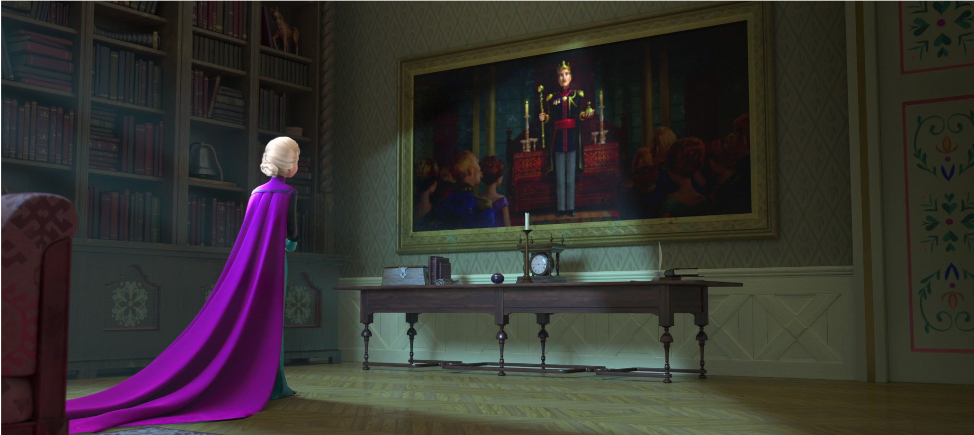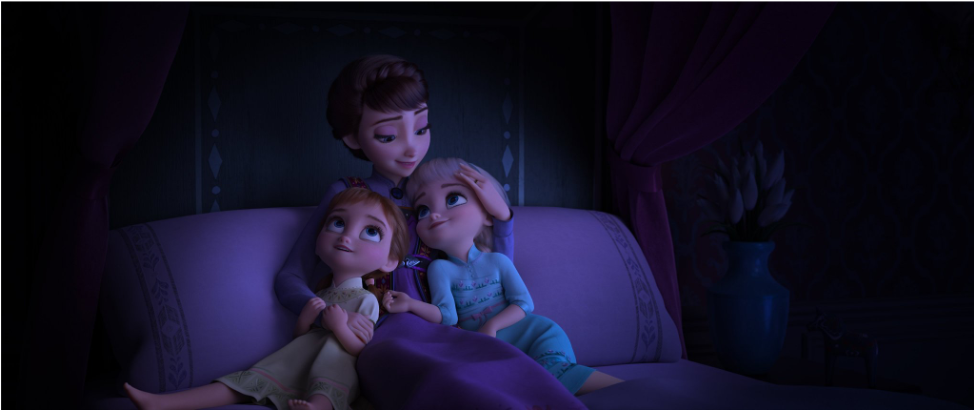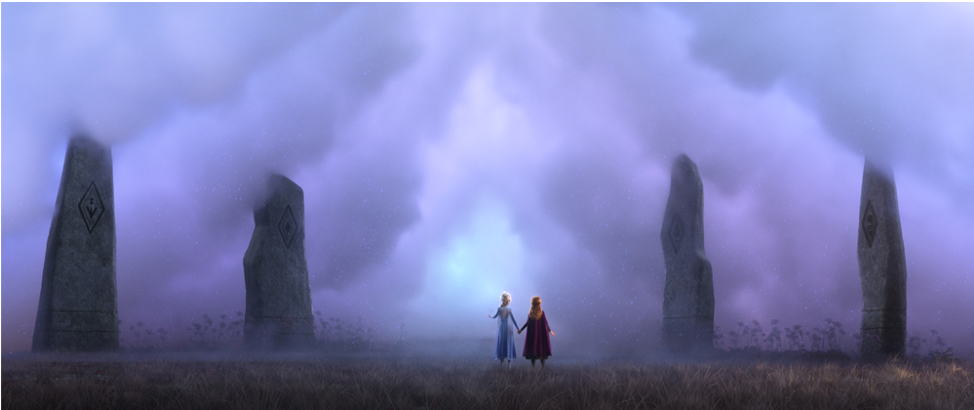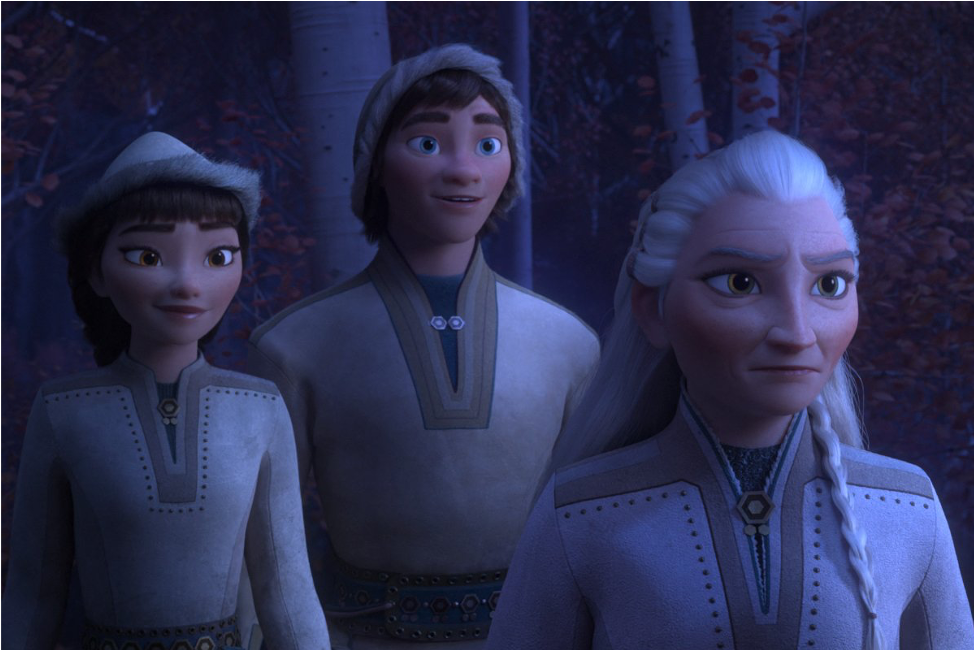I have seen Frozen II (2019) twice now. I think it is pretty great, yet, I have been quite disappointed in the number of bad takes on the film. Many critics have pegged the film as a retread of Frozen (2013),[i] but I argue Frozen II’s visuals, music and story are stronger than its predecessor. There is a lot I would love to talk more about, from the amazing water effects, and the queer anthem of finding community in the song “Show Yourself.” However, for this post, I will focus on the film’s politics of decolonization. In particular, I will examine the plot details and animation of the environment of Frozen II to explore the film’s narrative of decolonization. This blog post also examines how the film fits into the more recent Disney corporate practice of reacting to negative criticism and refining their work in response.
Frozen II begins in flashback, as young Anna and Elsa learn of the enchanted forest and its history. The forest is where the Indigenous tribe, the Northuldra, live alongside the spirits of nature: air, each, water, and fire. While the Arendellians, including their leader, King Runeard, appeared to come in peace in the past, even building a dam for the tribe, what was to be a celebratory cross-cultural exchange ends in violence. Angered by the fight between Arendellians and Northuldra, the elemental spirits disappear, and a wall of fog traps everyone in the Enchanted Forest. Young Agnarr, Anna and Elsa’s father, is mysteriously rescued and becomes king.
In the film’s present, Elsa awakens the dormant elemental spirits with her magical powers, causing them to wreak havoc on Arendelle. Consulting with the magical trolls, Elsa, Anna, and company set out on a quest to find the truth about what happened in the past, for without the truth, Arendelle has no future.
Whereas the first film detailed the negative impact their father, King Agnarr, had on Elsa (convincing her to live in fear of her powers) (Figure 1), Frozen II rectifies the previous film’s silence of Anna and Elsa’s mother, Iduna (she has only one line in the first film). Iduna proves central to uncovering the truth about the past, as well as Elsa finding herself.

Elsa reaches the magical realm of Ahtohallan, the magical place referred to in Iduna’s lullaby “All is Found,” a place “Where the north wind meets the sea/There’s a river full of memory” (Figure 2). Elsa sings “Show Yourself” as she enters Ahtohallan, eventually singing with her mother Iduna (who sings in the frozen memories), climactically singing “I am found!” In Ahtohallan, Elsa finds not only the truth about the past, but also a place for herself as someone both human, yet imbued with the (magical) power of nature.

Examining frozen memories of Ahtohallan, Elsa finds that her grandfather, King Runeard, betrayed the Northuldra, slaying their indigenous elder, resulting in the fighting that upset the spirits of the forest and the wall of fog stranding the Nothuldra and Arendellian soldiers in the mist.
Elsa confronts this memory of her grandfather, identifying that his actions emerged from fear, and states: “It is fear that cannot be trusted” (An additional point that would be prescient here: recognizing that King Runeard’s arrogance stems from the ideological ramifications of monarchy). But Elsa is soon overcome by the cold depths of Ahtohallan and sends the memory to Anna before completely freezing to ice.
Anna, confronted with the loss of her sister and her friend Olaf, demonstrates remarkable emotional maturity. Even in severe grief of losing the ones she loves, she still presses on to do “the next right thing” — destroy the dam, a false symbol of peace that masks the true act of betrayal against the indigenous population, even though such an act threatens the very existence of her home, Arendelle. With the aid of Kristoff, Sven, and Arendellian soldiers, Anna helps destroy the dam with the earth spirits and unfreeze Elsa from the icy cold of hate (see Figure 3). Elsa, with the assistance of the elemental spirits, diverts the torrent of water from destroying Arendelle. The fog dissipates, and there Northuldra and Arendellians once trapped are now free from the enchanted forest. Elsa reveals to Anna that they are the fifth spirits, acting as a bridge and connecting humans to the spirits of nature.

In particular, I want to focus my analysis on three things: the animation, the ending, and where this film fits into Disney’s larger industrial practices.
In addition to the narrative, the film’s beautiful animation of the natural environment continues the film’s focus on (de)colonization. The fog, acting as a barrier sectioning off the enchanted forest from the outside world (see Figure 4), also serves as a metaphor for lack of truth. Indeed, characters are literally ‘in the fog,’ as it were, regarding the past. As Arendelle is besieged by the spirits of nature in the first third of the film, the stones of the road literally unsettle the earth of the kingdom. (There is more to be said in terms of how the film gestures to how environmental justice is directly linked to Indigenous justice, but this discussion exceeds the scope of this post).

I think the film does a remarkable job of confronting colonialism and demonstrating the material conditions for reparations. In terms of the ending (i.e., the physical space of Arendelle threatened, but ultimately protected), a braver choice would certainly be to have the kingdom destroyed, and as its rebuilt, connections between the Northudra and the Arendelle are rebuilt as well. Perhaps the Arendellians temporarily live with the Northuldra for a while, and have a true cross-cultural connection, or perhaps for a film all about change and upsetting the status quo (something Olaf lampshades in the film), destroying Arendelle to rebuild into something new would be a generative opportunity to further a decolonial politic. For instance, should there really be a monarchy? The film could have taken inspiration from another Disney property, Taika Waititi’s Thor: Ragnarok (2017), another film with a commitment to decolonization.[ii] But as the film stands, it is a sound exploration of the legacies of colonialism, and the material necessity to undo past wrongdoing. As a Disney film, it also learned from and avoided repeating Disney’s previous mistakes, namely Pocahontas (1995).
Video essayist Lindsay Ellis discusses in detail how Disney has learned from its mistakes of Pocahontas in making Moana (2016).[iii] Frozen II also learns from Pocahontas, namely completely shutting down any “both sides” discourse to colonialism. Anna and Elsa confront the past and emphasize clear wrongdoing. Whereas Pocahontas dips into a “both sides” view of violence (i.e., the indigenous prepare for war, attempt to kill John Smith, and call the colonizers savages in the film’s messy, tone-deaf equivocation between colonizers and colonized), Frozen II makes clear that Arendelle is in the wrong, and must atone for its wrongdoing through material action.
Frozen II acting somewhat in response to previous Disney canon on seems appropriate, given the first film had jabbed at princess culture (cue Elsa telling Anna “You can’t marry a man you just met”). The film’s focus on the Northuldra is also a response to the call for more Sámi inclusion (Figure 5). Following Moana, which had a brain trust of Pacific Islands scholars and culture experts[iv], the team of Frozen II worked closely with a group of Sámi culture experts, called Verddet.[v] Frozen came under some criticism for having limited Sámi representation, as Sámi culture is mostly only present in the now-iconic opening song, “Vuelie,” written for the film by Frode Fjellheim, a South Sámi musician and composer. In Frozen II, the Northuldra sing it as they welcome Anna, Elsa, and others to their home. Giving the Vuelie song directly to the Northuldra helps address criticism of the previous film, pacing the beautiful voices directly into indigenous visual representation.

Indigenous representation becomes a bit knotty when it comes to Iduna. In revealing that Iduna is Northuldra, the film tiptoes into some dicey territory regarding race, but crucially, Anna and Elsa’s status as fifth spirit is not directly linked to biological essentialism (i.e., blood or other biological matter is not the focus of the film or the crux of where their power or status emerges from), but instead emerges from a commitment to do right by others.[vi] Such commitment is echoed throughout the film as Anna talks with multiple people on how to “do the next right thing,” the guiding phrase of her solo song near the end of the film. Iduna having put herself in danger to rescue Agnarr in the past despite being the enemy results in Elsa’s magical gifts. It is not biological essentialism, but the acts to do right by others, that connect spirits and human populations together.
To conclude, I think many assumed Frozen II to be more of the same from Disney, when in fact it has a lot to offer in terms of materialist critique of colonialism. If this blog post demonstrates anything, I hope it shows that it can be more productive to come to a text with an inquisitive mind and attentiveness to detail. Rich texts as Frozen II deserve it.
Jacqueline Ristola is a Ph.D. candidate in Film and Moving Image Studies at Concordia University, Montreal. She received her master’s degree in Cinema and Media studies from York University in 2017, where she also received a Graduate Diploma in Asian Studies from the York Centre for Asian Research. Her research areas include animation/anime studies, media industry studies, and queer theory. Her work is published in Animation Studies Online Journal, where she was awarded the inaugural Maureen Furniss Student Essay Award. She is currently a co-editor of a forthcoming issue on LGBTQ Animation for Synoptique: An Online Journal of Film and Moving Image Studies, and also has a forthcoming chapter in Representation in Steven Universe (Palgrave 2020).
[i] See for example: Kristen Page-Kirby, “Neither hot nor cool, Frozen II serves up lukewarm leftovers from the 2013 hit,” The Washington Post, November 20th, 2019, https://www.washingtonpost.com/goingoutguide/movies/neither-hot-nor-cool-frozen-ii-serves-up-lukewarm-leftovers-from-the-2013-hit/2019/11/20/b1e483a0-0572-11ea-ac12-3325d49eacaa_story.html?arc404=true; Sam Adams, “Frozen 2 Should Have Heeded the Lessons of “Let It Go”,” Slate, November 19, 2019, https://slate.com/culture/2019/11/frozen-2-review-disney-sequel.html.
[ii] Dan Taipua, “Thor and his magic patu. Notes on a very Māori Marvel movie,” The Spinoff, October 13, 2017, https://thespinoff.co.nz/atea/31-10-2017/thor-and-his-magic-patu-notes-on-a-very-maori-marvel-movie/.
[iii] Lindsay Ellis, “Pocahontas Was a Mistake, and Here’s Why!,” July 16, 2017, YouTube video, https://www.youtube.com/watch?v=2ARX0-AylFI.
[iv] Joanna Robinson, “How Pacific Islanders Helped Disney’s Moana Find Its Way,” Vanity Fair, November 16, 2016, https://www.vanityfair.com/hollywood/2016/11/moana-oceanic-trust-disney-controversy-pacific-islanders-polynesia.
[v] A few resources on the Verddet advisory group: 1) More on Indigenous consultations can be read here: John Last, “Hollywood gets Indigenous consultation right in Frozen 2, Sami experts say,” CBC, November 23, 2019, https://www.cbc.ca/news/canada/north/frozen-2-consultation-sami-1.5370801; and 2) A list of the Verddet members can be found here: https://www.sametinget.se/134104.
[vi] For more on biological essentialism, see Adrienne Keene, Rebecca Nagle, and Joseph M. Pierce’s syllabus on Elizabeth Warren, Cherokee Citizenship, and DNA Testing at http://www.criticalethnicstudiesjournal.org/blog/2018/12/19/syllabus-elizabeth-warren-cherokee-citizenship-and-dna-testing.

1 comment for ““Frozen II” and the Material Necessity of Decolonization”